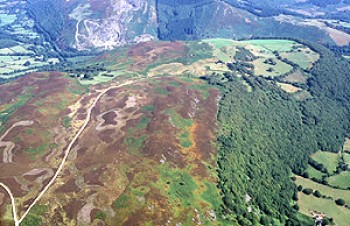
Cymraeg / English

|
Elan Valley Historic Landscape |

|
Character area map |

|
More photographs |
Historic Landscape Characterisation
The Elan Valley:
Carn Gafallt
Llanwrthwl and Rhayader Communities, Powys
(HLCA 1138)
Small isolated upland area between the Cwm Elan and Cwm Dulas valleys with steep, wooded sides, now partly managed as a nature reserve, with prehistoric burial monuments and traces of possibly post-medieval cultivation.

Historic background and key historic landscape characteristics
Small isolated and predominantly heather-covered upland area between the Cwm Elan Cwm Dulas valleys, between about 250-460m above Ordnance Datum. Some hill slopes bracken covered with rock outcrops and occasional large natural boulders.
The area formed part of the early medieval and medieval cantref of Builth, and was formerly part of the Glanusk estate, but was purchased by and is now partly managed as a nature reserve by the RSPB. Prehistoric activity is suggested by a group of probably Bronze Age burial cairns on the southern edge of the hill, above Talwrn, and by several isolated cairns elsewhere, suggesting that upland pastures may have been exploited for grazing from an early date. One of the cairns has a mythical association with the King Arthurís dog Cabal and the hunting of the wild boar Troynt, dating from perhaps the 8th century.
Former agricultural activity is indicated by a number of isolated areas with stone clearance cairns of ridge and furrow cultivation recorded by aerial reconnaissance. These are undated, but possibly belong to the post-medieval period. The small group of enclosed fields at Pen-y-rhiw and Gwarallt represent medieval or early post-medieval encroachment onto the upland common. A number of houses on the margins of the upland, inhabited in the mid 19th century, have since been abandoned, including the now ruinous building at Gwarallt above Crownant.
Sources
Guest 1849; Jones 1909-30; RCAHMW 1997; Wade-Evans 1938; Regional Sites and Monuments Record
For further information please contact the Clwyd-Powys Archaeological Trust at this address, or link to the Countryside Council for Wales' web site at www.ccw.gov.uk.
Privacy and cookies